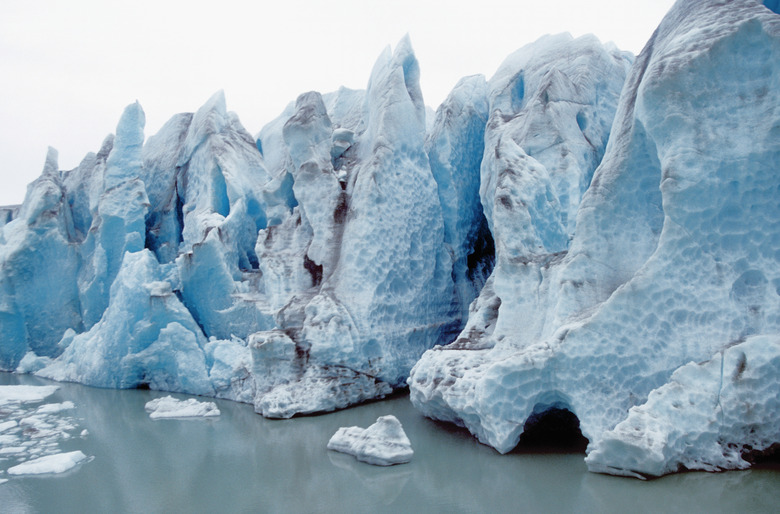How Do Glaciers Change The Landscape?
Glaciers are huge masses of ice that move across the land. Glaciers are often called rivers of ice for the way they move down mountainsides and carve valleys. Though climate change is threatening glaciers today, there are still many glaciers changing landscapes around the world through erosion and material deposition. Glacial landforms left behind by glaciers include moraines, drumlins, troughs, aretes, horns and cirques.
Types of Glaciers
Types of Glaciers
There are two types of glaciation: alpine glaciers, which form on mountainsides, and ice sheets, which form spreading domes that cover valleys, plains and mountains. Alpine glaciers create valleys by pushing soil and rocks out of their way as they grow. They are also known as valley or mountain glaciers.
Ice sheets used to cover most of North America and Europe during the last ice age. The largest ice sheets today, called continental glaciers, cover most of Greenland and Antarctica. Ice sheets do not create landscape features as they spread. They are so large and powerful that the land beneath them is typically smoothed out.
Power of Erosion
Power of Erosion
One of the main ways that glaciers change the landscape is through erosion, and the two main types are plucking and abrasion. As the glacier moves downhill, it plucks rocks from the ground and they become frozen in the glacier. With abrasion, any rocks that the glacier has frozen inside of it scrape the bedrock in the land below the ice, leaving scratchy striations. Freeze-thaw weathering also impacts the rock beneath glaciers as water in cracks freezes and expands in cold weather, breaking the rock away over time.
Evidence of Moraines
Evidence of Moraines
A moraine is material that is carried or moved by a glacier. There are three different types of moraines: lateral, medial and terminal. Lateral moraines are deposited along both sides of the glacier. Medial moraines are deposited in the middle of the glacier, which happens when the lateral moraines of two glaciers meet. Terminal moraines are material that is deposited at the end of a glacier, often as it is receding up a mountain.
When glaciers move and deposit moraine in a variety of ways, it can produce interesting landform features. Drumlins are hills of deposited moraine. Their size varies, but they will have a steep side and a sloping side, with the sloping side being closest to the glacier as it retreats.
Glacial Landforms Created by Deposition
Glacial Landforms Created by Deposition
Glacial troughs, also known as glaciated valleys, have flat valley floors and steep sides. These are long, U-shaped valleys carved by glaciers that have since disappeared. Fjords are a good example of coastal troughs carved out by glaciers. When the glaciers receded, ocean water filled in the floor of the valleys and created fjords (such as those seen in Norway).
Aretes, horns and cirques are other types of glacial landforms. When two glaciers next to one another wear a steep ridge into the rock, a crest of rock is left behind known as an arete. When glaciers erode away three or more aretes, a sharp-edged peak forms, which is known as a horn. The base of a glacier is able to carve large circular basins known as cirques.
Erratics on the Move
Erratics on the Move
Glaciers are slow, but extremely powerful. As they grow, the push forward down mountainsides, crushing and grinding almost everything in their way. That includes forests, hills and boulders. Rocks that are carried by glaciers, sometimes hundreds of miles, are called glacial erratics.
Glacial erratics are made up of a different material than the surrounding landscape they land in because they have traveled so far. One famous example is a 15,000-ton quartzite boulder called the Big Rock in Alberta, Canada, which traveled more than 1,000 miles during the last ice age.
Cite This Article
MLA
Taylor, Lindsey. "How Do Glaciers Change The Landscape?" sciencing.com, https://www.sciencing.com/do-glaciers-change-landscape-5127306/. 20 October 2021.
APA
Taylor, Lindsey. (2021, October 20). How Do Glaciers Change The Landscape?. sciencing.com. Retrieved from https://www.sciencing.com/do-glaciers-change-landscape-5127306/
Chicago
Taylor, Lindsey. How Do Glaciers Change The Landscape? last modified March 24, 2022. https://www.sciencing.com/do-glaciers-change-landscape-5127306/
